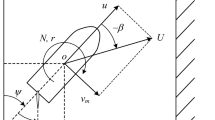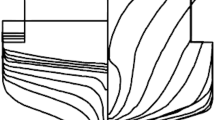Abstract
Broaching-to, an uncontrollable maneuvering problem that may occur in following and quartering seas, can induce large roll motion and sometimes capsizing due to violent yaw motions, e.g., Nicholson (Some Parametric Model Experiment to Investigate Broaching-to, pp 160–166, 1974). Broaching-to arises when a ship cannot maintain its desired course even under maximum steering effort. Previous experiments and numerical simulations of the broaching-to phenomenon have applied proportional-derivative (PD) control, which cannot provide the maximum steering effort. To maximize the steering effort, the previous study replaced PD control by optimal control theory by Maki et al. (J Jpn Soc Nav Archit Ocean Eng 7:207–212, 2008) and Maki et al. (J Jpn Soc Nav Archit Ocean Eng 8:115–122, 2008). A case of the ship control, when the ship developed large yaw motions despite the optimal control, was observed. However, because optimization techniques such as the variational method were insufficiently powerful for solving this highly nonlinear problem, the optimization could be performed only around local optima. The aim is to globally seek a better local solution among the numerous local optima. To achieve this goal, the authors applied the Covariance Matrix Adaption Evolution Strategy (CMA-ES), a state-of-the-art algorithm in evolutionary computation for derivative-free continuous optimization. The optimal rudder control for preventing broaching-to is then obtained, and its characteristics are discussed.













Similar content being viewed by others

References
Nicholson K (1974) Some parametric model experiment to investigate broaching-to. Proc Int Symp dynamics of marine vehicle and structure, pp.160–166
Oakley OH, Paulling JR, Wood PD (1974) Ship motions and capsizing in astern seas. In: Proceedings of the 10th Naval Hydrodynamics Symposium, MIT, 1V-1, pp 1–51
Maki A, Umeda N (2009) Bifurcation and chaos in yaw motion of a ship at lower speed in waves and its prevention using optimal control. In: Proceedings of the 10th International Conference on stability of ships and ocean vehicles, pp 429–440
Umeda N, Hamamoto M (2000) Capsize of ship models in following/quartering waves: physical experiments and nonlinear dynamics. Philos Trans Math Phys Eng Sci 358(1771):1883–1904
Umeda N, Yamamura S, Matsuda A, Maki A, Hashimoto H (2008) Model experiments on extreme motions of a wave-piercing tumblehome vessel in following and quartering waves. J Jpn Soc Naval Archit Ocean Eng 8:123–129
Hashimoto H, Umeda N, Matsuda A (2011) Broaching prediction of a wave-piercing tumblehome vessel with twin screws and twin rudders. J Mar Sci Technol 16(4):448–461
Renilson MR (1986) The seabrake—a device of assessing in the prevention of broaching-to. Proc Int Conf Stab Ships Ocean Veh Gdansk 2:75–80
Umeda N, Matsuda M, Takagi M (1999) Model experiment on anti-broaching steering system. J Soc Naval Archit Jpn 185:41–48
Maki A, Umeda N, Ueno S (2008) Application of optimal control theory to course keeping problem in following seas. J Jpn Soc Naval Archit Ocean Eng (In Japanese) 7:207–212
Maki A, Umeda N, Ueno S (2008) Investigation on broaching-to using optimal control theory. J Jpn Soc Naval Archit Ocean Eng (In Japanese) 8:115–122
Wu AK, Miel A (1980) Sequential conjugate gradient−restoration algorithm for optimal control problems with nondifferential constraints and boundary conditions Part l, Optimal control applications and methods, Vol. 1–1
Ohtsu K (2004) The numerical solution of minimum time maneuvering problems by a NLP method. J Jpn Soc Naval Archit Ocean Eng 196:99–104
Hansen N, Auger A (2014) Principled design of continuous stochastic search: from theory to practice. In: Borenstein Y, Moraglio A (eds) Theory and principled methods for designing metaheustics. Springer, Berlin, pp 145–180
Hansen N (2016) The CMA evolution strategy: a tutorial. ArXiv e-prints, arXiv:1604.00772
Renilson MR (1982) An investigation into the factors affecting the likelihood of broaching-to in following seas. In: Proceeding of the second international conference on stability of ships and ocean vehicles, Tokyo
Renilson MR (1996) Summary of discussion on session 1, (Surf-riding, Broaching and Capsizing in Following/Quartering Seas). Proceeding of the Second Workshop on stability and operational safety of ships, Osaka
Umeda N, Hashimoto H (2002) Qualitative aspects of nonlinear ships motions in following and quartering seas with high forward velocity. J Mar Sci Technol 6(3):111–121
Motora S, Fujino M, Koyanagi M, Ishida S, Shimada K, Maki T (1981) A consideration on the mechanism of occurrence of the broaching-to phenomenon. J Jpn Soc Naval Archit Ocean Eng (in Japanese) 150:211–222
Umeda N, Renilson MR (1992) In: Wilson PA (ed) Broaching—a dynamic analysis of yaw behavior of a vessel in a following sea, maneuvering and control of marine craft. Computational Mechanics Publications, Southampton
Htet TZ, Umeda N, Maki A, Matsuda A, Terada D (2019) Estimation of broaching probability using wave-induced forces and moments measured in captive model tests. J Mar Sci Technol 24(1):317–327
Akimoto Y, Nagata Y, Ono I, Kobayashi K (2012) Theoretical foundation for CMA-ES from information geometry perspective. Algorithmica 64(4):698–716
Hansen N, Auger A, Ros R, Finck S, Pošík P (2010) Comparing results of 31 algorithms from the black-box optimization benchmarking BBOB-2009. Proceedings of the 12th annual conference companion on genetic and evolutionary computation, pp.1689–1696
Rios LM, Sahinidis NV (2013) Derivative-free optimization: a review of algorithms and comparison of software implementations. J Glob Optim 56(3):1247–1293
Auger A, Hansen N (2005) A restart CMA evolution strategy with increasing population size. In Proc. of the 2005 IEEE Congress on evolutionary computation, pp 1769–1776
Nishida K, Akimoto Y (2018) PSA-CMA-ES: CMA-ES with population size adaptation. In Proc. of the genetic and evolutionary computation conference, GECCO 2018
Sakamoto N, Akimoto Y (2017) Modified box constraint handling for the covariance matrix adaptation evolution strategy. In GECCO ’17 Companion, Berlin, Germany, July 15–19, 2017, New York, New York, USA, 2017, pp 183–184
Maki A, Sakamoto N, Akimoto Y, Nishikawa H, Umeda N (2019) Application of optimal control theory based on the evolution strategy (CMA‑ES) to automatic berthing. J Mar Sci Technol, First online. doi: 10.1007/s00773-019-00642-3
Akimoto Y (2012) Analysis of a natural gradient algorithm on monotonic convex-quadratic-composite functions. In Proc. of GECCO '12: genetic and evolutionary computation conference, pp 1293–1300
Acknowledgements
This work was supported by a Grant-in-Aid for Scientific Research from the Japan Society for Promotion of Science (JSPS KAKENHI Grant number 19H02360). The authors would like to thank Enago (www.enago.jp) for the English language review.
Author information
Authors and Affiliations
Corresponding author
Additional information
Publisher's Note
Springer Nature remains neutral with regard to jurisdictional claims in published maps and institutional affiliations.
About this article
Cite this article
Maki, A., Sakamoto, N., Akimoto, Y. et al. On broaching-to prevention using optimal control theory with evolution strategy (CMA-ES). J Mar Sci Technol 26, 71–87 (2021). https://doi.org/10.1007/s00773-020-00722-9
Received:
Accepted:
Published:
Issue Date:
DOI: https://doi.org/10.1007/s00773-020-00722-9



